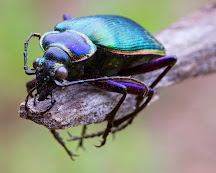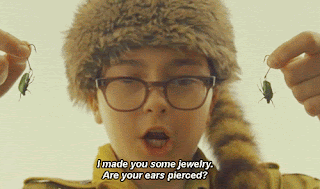 |
| Fiery Searcher larva (R) eating a Pipevine Swallowtail larva |
These beetles live throughout North America, but their numbers are largest in eastern states. They are nocturnal, so even if you live in an area where they are prolific you may not see them. They spend their daylight hours in crevices, under leaf litter, logs and rocks and venture out in the dark. This night-life suits them well; it allows them to stay hidden from those animals that like to prey on them and the insects that they like to eat are also hiding in daylight for the same reasons. As pests come out at night with a false sense of security and their eyes on your plants, the fiery searchers are ready to snatch them up.
Fiery searchers are usually found in fields and gardens, although some live on forest floors. These beetles have wings, but rarely fly. Instead, they use their long legs to scamper up branches and tree trunks to grab a meal. They are especially fond of tent caterpillars and gypsy moth larvae, which they find up in the trees. Fiery searchers don’t just use their long legs to climb trees, their legs allow them to run very fast to chase down prey. Their burst of speed in pursuit of prey is similar to a cheetah’s, so much so that they have been called the cheetah of the insect world.
Fiery searchers are around from May through November but are most active from May through June when trees have leafed out and caterpillar populations boom. In the fall, they will be scuttling around getting the last of the bug goodies before it gets too cold and it’s time to overwinter. They like to spend their winters under some bark or under a rock.
These beetles are glorious – not just in how pretty they are, but in their hunting game. They literally take no prisoners. Here’s a really informative video that shows them in action and this article contains three separate short illustrative videos . Enjoy the glory that is the fiery searcher on the hunt.
Take Care
Submitted by Pam









I was gathering muscadine near my home in Independence County, AR. I thought a small twig was on my ear, when I wiped it away I saw it was a bright green beetle. Then I was hit with the smell! I said it was bad cheese. I was a little worried if was poisonous, so I googled it. I am relieved that it is not, but I still seem to have the rotten smell in my nose.
ReplyDelete